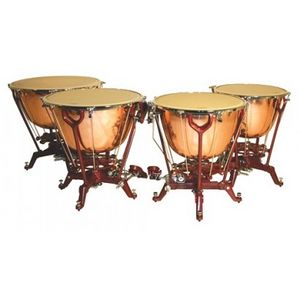Percussion History
 Range of Timpani | |
 | |
| Timpani | |
|---|---|
| Range of Timpani |
History Introduction - Type here
Antiquity (c. 200,000 B.C.) to Medieval (c. 1100 A.D.)
The Paleolithic Era
Fossil and Archaeological evidence shows us that humans began appearing in the eastern regions of Africa, specifically in the regions near present-day Kenya. (c. 198,000 B.C.) Almost as soon as humans began to spread into the jungles and seas surrounding Africa, primitive music began to develop. Body percussion was the apex form of instrumentation during the beginning years of man. However, striking one’s body to create ‘music’ was not the intention, there was no connection to striking the body to producing a sound to be appreciated. This however was short-lived, using body percussion assisted in the hunt, dancing and rituals, and soon became important in primitive East African culture, it still was taken seriously, and not used as a recreational outlet, such as for entertainment purposes.1 As human ideologies developed, they began to strike other objects. Sticks were important, as well as stones, especially when it came to testing sounds. One of the earliest human societies, the Zulu, were known to beat their shields and hunting bows in times of battle, a trait that would be used by civilizations throughout the world. Striking objects in order to obtain a specific sound slowly began to incorporate itself into the culture of the area, using objects that have been made for other purposes, such as bows and shields for battle, began to replace body percussion. After a successful hunt, a hunter would place the bows in front of him with the string facing him, and strike the string to assist in the rhythm of the victory dances for a successful hunt. As stones and sticks would become more involved in societies to create tools, early man of the Paleolithic Era (c. 198,000 B.C. – 10,000 B.C.) would begin looking for objects that resonated. Having this goal in mind, man began to discover idiophones, an object that vibrates when struck to produce a sound. These idiophones would be shaken, stamped, scraped, struck, or struck together (concussion). These included, but were not limited to: Proto-Claves, Xylophones, Wood Blocks, Rattles, Rubbed Shells, Scrapers, Stamped Pits, and Proto-Cymbals (Stone). Most if not all of these instruments, were created from wood, or the flora and fauna around the primitive societies. These instruments would comprise the Early Strata Instruments of the Paleolithic Era of the Stone Age.
The Neolithic Era
As we progress through the Neolithic Era, we can follow man as he journeys throughout the world. After the first Ice Age in 58,000 B.C., humans leave Africa and begin a journey through India and the Far East. Some humans leave the continent and began island-hopping until they reached Australia in 48,000 B.C.. In 38,000 B.C., evidence has been found that suggest humans began to travel north and east, to fill out the rest of the continent, and by 33,000 B.C., the Middle East and Asia had become very populated. Shortly before the Mid-Neolithic Era begins in 15,200 B.C., creativity begins to appear amongst the peoples of the world, specifically Africa. Humans there would begin to create wollogallu’s, which translates to ‘Drum of the Earth’. Stamping pits, which were platforms made of wood, would be placed over a hand-dug pit. A larger pit would then be dug next to the first one, and when the Stamping Pit was struck, vibrations would be felt through the second, larger pit, and the earthen cavity would create a larger, resonant sound. Humans also started to place the skins of animals over hollowed out stumps, or pots, and would then strike the skin with a bare hand to create a sound. These innovations would take us into the Mid-Neolithic Era of the World. Also, during 13,000 B.C., humans use the Bering Strait to travel from Eastern Europe to the Americas. Once the Mid-Neolithic Era (15,200 B.C. – 4,500 B.C.) of the Stone Age begins, we see new instruments begin to appear on many continents. Two cultures of significance would begin to produce slit drums. These drums were generally made of wood, and would either have a slit traveling through them to produce the resonance, or they would be hollowed out and have a slits that would resemble two tongues that would be in an H shape. The tongue slabs would be struck to produce two distinct sounds. It’s important to note, that wooden ‘gongs’ may often be referring to the African slit drum. In China, the t’ak was developed, which was a wooden slit drum. It would have a single resonating chamber and would be struck to produce a sound. In Africa, the gong would often be crafted from large logs that would be hollowed out. The wooden tongues would then be carved into the log and it would be adorned with carvings. It was often associated with housing the spirits of the dead. The Stamping Pit also would evolve into the Stamping Tube, which was a cylindrical drum that would be struck upon the ground to make a sound, rather than digging a hole and placing a platform over it. The most important contribution to percussion instruments of the Stone Age however, was the invention of the membranophone: the drum. As this instrument becomes prominent, music is used more for recreation in some cultures and less for serious events. We then move into the transition period of the Bronze Age, we move away from the Mid-Neolithic, and into Late Strata and Recent Neolithic Era.
Medieval (476 A.D.) to Classical (c. 1750)
Text Text TExt
Early Romantic Era (c. 1800 - 1910)
text Text Text
Late Romantic (c. 1900) to Early Modern (c. 1950)
text Text Text
Early Modern (c. 1950 - 1980)
text text text
The Modern Era (c. 1970 - 2017)
text text text
References